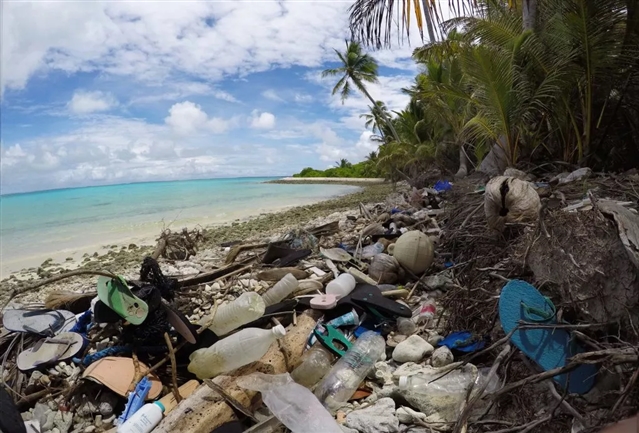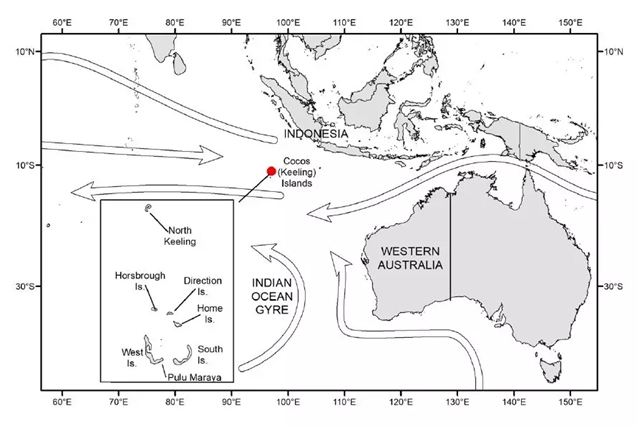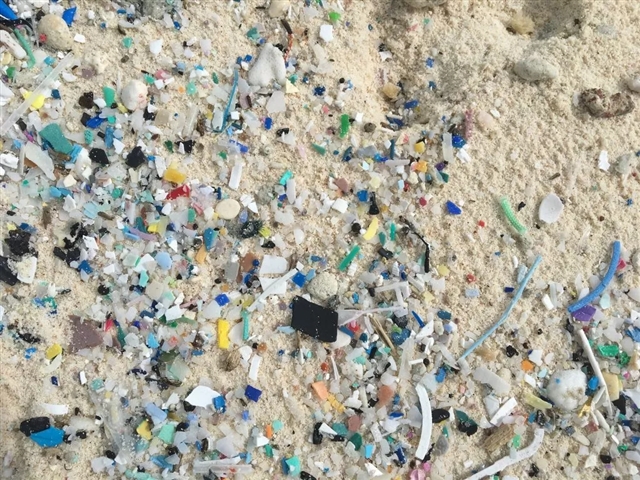|
|
|
|
|
偏僻的澳洲群岛上,分布着238吨人为垃圾 | 《科学报告》 |
|
|
论文标题:Significant plastic accumulation on the Cocos (Keeling) Islands, Australia
期刊:Scientific Reports
作者:J. L. Lavers, L. Dicks, M. R. Dicks, A. Finger
发表时间:2019/05/16
数字识别码: 10.1038/s41598-019-43375-4
原文链接:http://t.cn/EKrhk9B
微信链接:https://mp.weixin.qq.com/s/OI13Hd33OUZ4c3PGgIJfVQ
根据《科学报告》本周发表的一项研究Significant plastic accumulation on the Cocos (Keeling) Islands, Australia,2017年估计有4.14亿件人为垃圾分布在偏远的科科斯(基林)群岛(CKI)上,这些垃圾包括塑料、泡沫、金属和玻璃,总重量达238吨。CKI由27个小岛组成,距离澳大利亚西北海岸2100公里,这项研究也是首个针对CKI的综合调查。

图1:Direction Island北边海滩上的垃圾 图源:Silke Stuckenbrock
澳大利亚塔斯马尼亚大学的Jennifer Lavers和同事在2017年对7座岛屿共计25个海滩的大型垃圾和微型垃圾展开了综合调查,调查面积占到CKI陆块面积的88%。微型垃圾是大型垃圾分解后的小碎片,作者发现微型垃圾占CKI海滩所有垃圾的60%以上。鞋子和一次性消费品(如食品包装袋、饮料瓶、吸管和牙刷)占到可识别垃圾的近25%。在研究人员记录到的所有垃圾中,塑料制品占了95%以上,其次分别为泡沫(3.06%)和其他类型的垃圾(0.63%)。

图2:科科斯(基林)群岛的位置 图源:Lavers 等

图3:South Island东边的微型垃圾(1-5mm) 图源:Jennifer Lavers
研究人员预计滩面下1-10厘米处可能掩埋了338,355,473件垃圾,是滩面可见垃圾数量(预计约有12,868,379件)的26倍之多。由于此前大部分全球垃圾调查只关注滩面垃圾,这些调查可能因此严重低估了垃圾堆积的规模。
作者认为亟需采取多管齐下的方式防止更多塑料制品流入海洋,比如积极采用限制塑料生产和消费的策略,普遍禁用一次性用品,以及进行有效的废物管理。
摘要:For over 60 years, our oceans have been a reservoir for exponentially increasing amounts of plastic waste. Plastic has been documented at all levels of the marine food web, from the deepest oceanic trenches to the most far-flung beaches. Here, we present data on the presence of significant quantities of plastic on the remote Cocos (Keeling) Island group, located 2,100 km off the northwest coast of Australia. From our comprehensive surveys of debris on the beach surface, buried, and beach-back vegetation, we estimate there are 414 million anthropogenic debris items, weighing 238 tonnes, currently deposited on the Cocos (Keeling) Island group. Of the identifiable items, ~25% were classified as disposable plastics, including straws, bags, and toothbrushes. Debris buried up to 10 cm below the surface is estimated to account for 93% (~383 million items) of all debris present on Cocos, the majority of which (~60%) is comprised of micro-debris (2–5 mm). In the absence of meaningful change, debris will accumulate rapidly on the world’s beaches. Small, buried items pose considerable challenges for wildlife, and volunteers charged with the task of cleaning-up, thus preventing new items from entering the ocean remains key to addressing this issue.
阅读论文全文请访问:http://t.cn/EKrhk9B
期刊介绍:Scientific Reports (https://www.nature.com/srep/) is an online, open access journal from the publishers of Nature. We publish scientifically valid primary research from all areas of the natural and clinical sciences.
The 2017 journal metrics for Scientific Reports are as follows:
•2-year impact factor: 4.122
•5-year impact factor: 4.609
•Immediacy index: 0.576
•Eigenfactor® score: 0.71896
•Article Influence Score: 1.356
•2-year Median: 2
(来源:科学网)
特别声明:本文转载仅仅是出于传播信息的需要,并不意味着代表本网站观点或证实其内容的真实性;如其他媒体、网站或个人从本网站转载使用,须保留本网站注明的“来源”,并自负版权等法律责任;作者如果不希望被转载或者联系转载稿费等事宜,请与我们接洽。